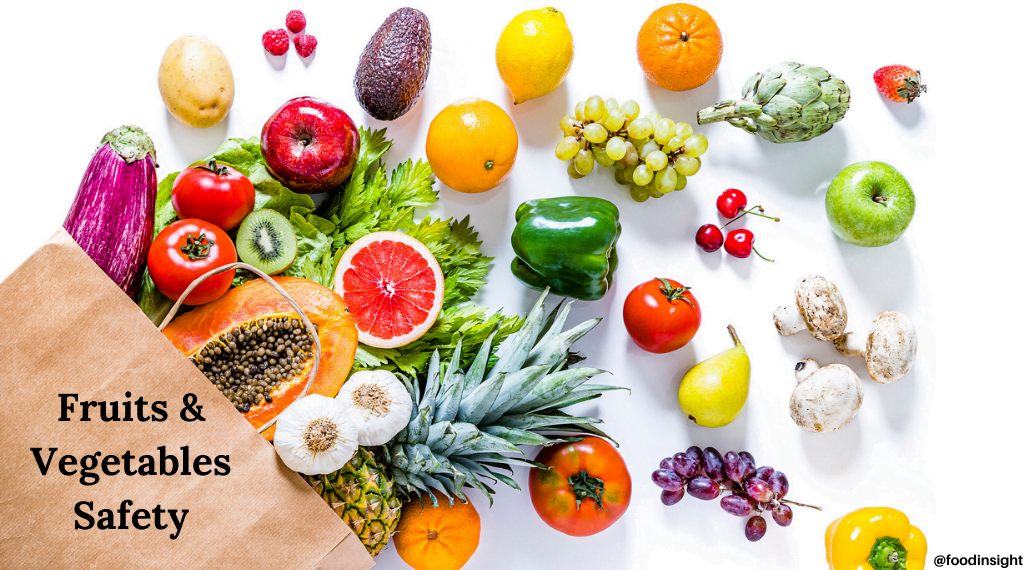June 7 marks World Food Safety Day and IFIC celebrates each year by considering how our food-supply chain can improve its safety—a critical part of our everyday nutrition and wellness. Consumers can play an active role in keeping themselves safe by practicing safe food handling— especially with fruit and vegetable consumption. This time of year, many of us are enjoying the variety of fruits and vegetables warm weather brings and being sure to consume plentiful fruits and vegetables every day helps promote good health throughout our entire lifespan.
The 2020–2025 Dietary Guidelines for Americans encourage increased consumption of fruits and vegetables due to the fact that “almost 90 percent of the U.S. population does not meet the recommendation for vegetables” and “about 80 percent of the U.S. population does not meet fruit recommendations.” Even if you’re not surprised that so many of us are not “making half of [our] plates fruits and vegetables” (as recommended by the Dietary Guidelines), there are many easy tips for incorporating more of these healthy foods into your daily routine.
As you begin your fruit and veggie consumption crusade, it’s important to know how to safely handle fresh produce. While many of us may opt for frozen or canned fruits and veggies (which are conveniently shelf-stable and still pack a punch nutritionally), the warmer temperatures of spring and summer may warrant a nice stroll down your local produce section or a trip to your neighborhood farmers’ market. Let’s walk through some reminders about how to safely handle fresh produce.
Filling your shopping cart
The current Dietary Guidelines stress that their “recommendations can ‘meet people where they are,’ from personal preferences to cultural foodways, and include budgetary considerations.” Among the guidelines’ efforts to reflect the cultural, geographical, and economic diversity of the U.S. is its belief that both conventionally grown and organic produce are healthy choices. That is, neither option is superior in safety or nutritional value. Both organic and conventional farming techniques use pesticides to ward off pests such as insects, weeds and microbes. However, organic farmers use a U.S. Department of Agriculture (USDA)–approved list of pesticides that are specifically designated for declaring the produce from that farm organic. Notably, the use of pesticides on all farms is closely monitored and regulated by the U.S. Environmental Protection Agency (EPA), the U.S. Food and Drug Administration (FDA) and the USDA. The FDA and USDA share responsibility for monitoring levels of pesticide residues in and on foods; these agencies work to ensure that pesticide residues, if present at all, are within safe levels (as determined by the EPA) for both adults and children, with public reports on these levels published annually.
While all produce you buy in the U.S. should be safe from a pesticide standpoint, there are some further guidelines to consider when purchasing fruits and vegetables. Advice out of the Centers for Disease Control and Prevention (CDC) includes choosing produce that isn’t bruised or damaged. Bruised produce can often be on the verge of spoiling or may already be spoiled. Additionally, broken skin or peels on produce can allow the fruit to be contaminated with microbial pests. The CDC also advises that when choosing pre-cut fruits and vegetables, it’s best to pick ones that have been kept cold by being refrigerated or placed on ice.
Fruits and veggies in the house
So what should you do to your fresh produce when you get home, before you eat it? Simple: Just rinse it with clean running water (unless you have pre-packed produce that says the contents have already been washed). Accessing clean water is the first step in safely eliminating any contaminants—including dirt, microbes (such as Salmonella and Campylobacter, which can cause foodborne illness) or lingering pesticide residues. You should also be sure to wash produce that has a peel, even if you plan to discard it. Recommendations from the CDC on how to wash your produce include:
- Avoid washing fruits and vegetables with soap, detergent, or a commercial produce wash. This is not recommended. Also, never use bleach solutions or other disinfecting products on food (these chemicals can make you very ill if ingested).
- Remove damaged or bruised areas of produce before preparing or eating them.
- Dry fruits and vegetables with a clean paper towel after you are finished washing them.
Now that your produce is clean, you may be ready to make your dish or have a snack. In addition to washing your produce, you should also be sure to prepare your fruits and vegetables with clean hands and utensils. Of note, there are two more safe handling steps you should remember—separate and chill. Produce should be stored and prepared separately from raw meat, poultry and seafood. This means that prepping utensils used while making the produce and animal protein parts of your meals—like cutting boards and knives—should be used separately as well. Finally, you should refrigerate (or freeze) fruits and veggies in a closed container within two hours of cutting, peeling or cooking them (or within one hour if the atmospheric temperature is 90˚F or higher). Also, it is a good idea to regularly check the temperature of your refrigerator and freezer with an appliance thermometer. The refrigerator should be set at 40°F or below and the freezer at 0°F or below.
We hope these guidelines and tips help you get well on your way to building healthy plates packed with produce!
